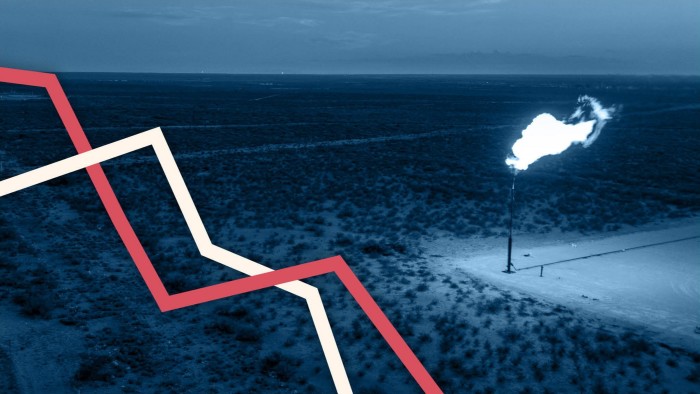Unlock the Editor’s Digest for free
Roula Khalaf, Editor of the FT, selects her favourite stories in this weekly newsletter.
US oil companies are cutting spending and idling drilling rigs, as Donald Trump’s tariffs push up costs and falling crude prices squeeze profits, prompting executives to warn that a decade-long shale boom is ending.
Surprise decisions by the Opec+ cartel to pump more oil have compounded the gloom across the US oil patch, sparking fears of a new price war and prompting analysts to cut output forecasts.
“We’re on high alert at this point,” Clay Gaspar, chief executive officer at Devon Energy in Oklahoma City, told investors this month. “Everything is on the table as we move into a more distressed environment.”
Oil output will fall by 1.1 per cent next year to 13.3mn barrels a day, according to S&P Global Commodity Insights, as prolific shale drillers that made the US the world’s biggest producer idle rigs in the face of prices driven lower by fears of oversupply and Trump’s trade war.
That would mark the first annual decline in a decade, excluding the 2020 pandemic when collapsing demand sent oil prices below zero and triggered widespread bankruptcies across states such as Texas and North Dakota.
US oil prices settled lower again on Friday, ending the week at $61.53 a barrel, down about 23 per cent from its high point this year. Shale producers need an oil price of $65 a barrel to break even, according to the quarterly energy survey by the Federal Reserve Bank of Dallas.
“The watchword now is, ‘hang in there’,” Herbert Vogel, chief executive officer at SM Energy in Denver, said at the Super DUG conference in Fort Worth.
A fall in production would end a stunning run in US energy, where the shale revolution delivered ever greater volumes of cheap oil and gas to power the economy, a boost to GDP and labour markets, and an export surge that improved the country’s trade balance.
Soaring shale output has also broken the US’s dependence on foreign suppliers such as Saudi Arabia and other Opec cartel members, while freeing the White House to target exporters such as Iran, Russia and Venezuela with sanctions.
Trump has promised to “unleash” more drilling and production in a bid to secure US “energy dominance”. But production, which hit a record high under his predecessor Joe Biden, could fall still further if prices keep sinking.
Scott Sheffield, the former head of shale driller Pioneer Natural Resources, told the Financial Times that if crude drops to $50 a barrel, US production would probably lose up to 300,000 barrels a day — more than the total output of some smaller Opec members.
Riyadh’s decision to pump more oil in recent months would be a direct threat to US producers’ share of the global market, he suggested.
“Saudi is trying to regain market share and they’ll probably get it over the next five years,” Sheffield said.
The onshore US oil rig count, a barometer of drilling activity, was 553 last week, down 10 since the week earlier and 26 lower than a year ago, according to oilfield services company Baker Hughes.
Some big producers are already shedding jobs. Chevron and BP have between them announced 15,000 job cuts globally, though in the US so far employment in the sector has remained relatively stable this year, according to the US Bureau of Labor Statistics.
The top 20 US shale producers, excluding ExxonMobil and Chevron, slashed their 2025 capital expenditure budgets by about $1.8bn, or 3 per cent, according to Enverus, an energy research firm.
“As operators, we cannot control the macro, but we can control how we respond,” said Vicki Hollub, chief executive of Occidental Petroleum, which cut rig count by two in the first quarter.
Many companies will slash more if prices hit $50 a barrel — the price Trump officials have indicated would help tame inflation.
“In this environment, we drop the rigs and buy back stock,” said Travis Stice, chair and chief executive officer at Diamondback Energy, which recently warned investors US oil production has probably peaked. “Every single conversation I’ve had is that this oil price won’t work.”
But the president’s other policies are also rattling the sector. Tariffs have pushed up the prices of steel and aluminium — crucial inputs in the oil patch. The price of casing, the metal used to line wells and the largest expense to drill a well, has risen 10 per cent in the past quarter alone.
“The economics will be challenged. We’ll see more capital pullback as the quarters progress,” said Doug Lawlor, chief executive of Continental Resources, one of the country’s biggest privately held energy companies.
That will force companies to batten down the hatches further as they try to keep Wall Street investors happy by protecting free cash flow to pay dividends and repay debt.
“You have to focus on dividends, they’re sacrosanct in this environment,” said Jim Rogers, partner at Petrie Partners, a boutique investment firm in Houston.
https://www.ft.com/content/2ca65bb8-335d-4fe4-a43a-7fb20bc9d396


